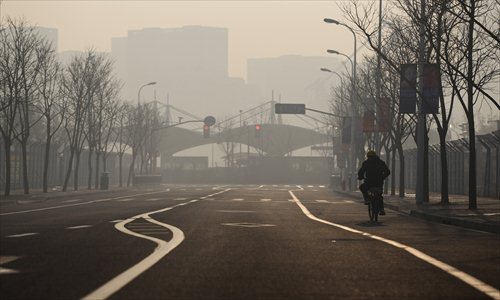
A bicyclist rides through the heavy smog in Huangpu district Wednesday, when the city's air pollution index hit a record high. Photo: Cai Xianmin/GT
The severe air pollution that engulfed Shanghai Wednesday will ease Thursday, though slowly, as the dead winds that have allowed pollutants to accumulate were not expected to pick up by much.
Shanghai's Air Quality Index (AQI), which measures air pollution in the city, hit a record high of 273 as of 5 pm Wednesday, according to the Shanghai Environmental Monitoring Center. A reading over 200 indicates a heavy level of pollution.
The primary cause of the air pollution was the sand and smog that blew in late Tuesday from northern China, said Duan Yusen, the monitoring center's chief forecaster.
"The lack of wind failed to disperse the particles Wednesday," Duan told the Global Times. "The wind will pick up a bit Thursday, but not enough to effectively improve the air quality."
A heavy haze descended Tuesday on a 1.3-million-square-kilometer swath of northern China, accounting for roughly one-seventh of the country, causing several highways to close due to the low visibility, according to the Beijing Times.
The sand and other pollutants added to the automobile exhaust and power plant emissions to raise the level of PM 2.5 in the city, which pushed up the AQI, Duan said.
PM 2.5 refers to particulate matter less than 2.5 microns in diameter. The particles are considered dangerous to human health because their small size allows them to lodge deeply in the lungs, where they can cause or aggravate respiratory illnesses.
The local transportation authority imposed lower speed limits on some highways during the day due to poor visibility, according to a news report on Shanghai Television Station Wednesday.
The local environmental authority suggested Wednesday that children, senior citizens and people suffering from heart and respiratory diseases stay indoors.

Copyright ©1999-2011 Chinanews.com. All rights reserved.
Reproduction in whole or in part without permission is prohibited.